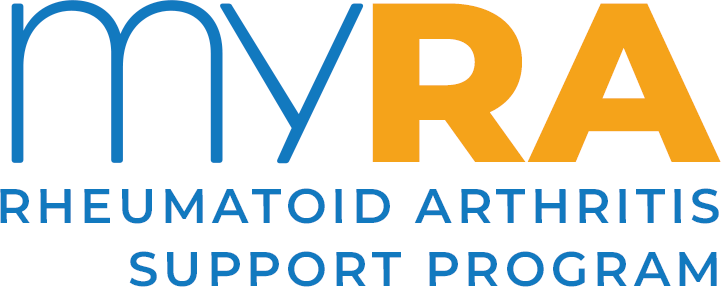
The first thing to do is to ask yourself: Why are you being active? Do you want to control your rheumatoid arthritis (RA) symptoms, lose weight, sleep better, increase your energy, gain strength, add muscle tone and flexibility, or just feel a heightened sense of wellbeing?
Each individual is motivated to become active by something unique to them and so it is important to find the thing that is most important to you and not to anyone else. If you focus on the benefits that you can get from exercise then you have a better chance of staying active.
Make a contract with yourself and hang it somewhere you can see it to remind you of your reasons for being active and your commitment to achieving your goals.
Have the right gear. This can make all the difference in the comfort level of your workout and as a result it will make the workout more enjoyable for you. A good pair of shoes is essential. And weather resistant clothing or a membership to an indoor gym can help you fight off your own excuses when weather conditions are less than ideal.
My healthcare team
Before you start to exercise it is important to talk to your healthcare team. You can ask your doctor for a referral to a physiotherapist or exercise physiologist who has experience working with people with RA and can help you find the exercise plan best tailored to give you the most benefit with the least aggravation of your joints.
Planning
One of the most challenging and important elements of a successful exercise regime is maintaining a regular cycle all year-round. This can be especially difficult when you are experiencing pain, stiffness or fatigue. But these symptoms are the very reasons to make exercise a habit!
Scientific evidence shows that people with RA who exercise regularly get significant symptom relief, giving them a far greater quality of life.
Maintaining your exercise regime does take a strong commitment but by coming up with a plan you can give yourself every chance of making exercise a success! For example, depending on your interests you can do a half hour session of aerobic activity, such as walking, every weekday evening and a 30 minute session of muscle strengthening in the gym on a Wednesday and a Saturday.
When it comes to living the best you can with arthritis, you need to determine what strategies and tactics make sense and are appropriate for you.
Creating my plan
- Make exercise a priority: Plan and prepare in advance so your time for exercise is not compromised. Adopt the mindset that other things can wait! Exercise is your priority. Remember, you can get active in many ways, so look for opportunities whenever and wherever you can find them.
- Set goals: Set yourself up for success by making goals that are achievable taking into account your current fitness level and your interests and lifestyle. It’s a good idea to have a big goal, but wise too to set small, realistic goals that will work like stepping stones, helping you reach the bigger objective.
- Anticipate obstacles: Pain, fatigue, illness, work or other obligations, and even the weather can mess up your plans. Have a plan B in place and know when rest is the better plan.
- Do what you enjoy: Your chances of sticking with an activity will be far greater if it is something you like, that feels good or excites you, or that makes you feel happy while you’re doing it. Also, if you keep it simple you’re more likely to keep at it.
How much can I do?
Be as active as your ability allows and set goals to help you achieve the adult guidelines (30 minutes of moderate intensity activity 5 days of the week). You can do 30 minutes continuously or combine several 10 to 15 minute sessions. If you have not exercised for a while, you may need to start with shorter sessions and build up slowly.
Talk to your doctor or a physiotherapist about getting started to help you avoid an injury through over-doing it. Don’t forget that activities such as gardening, playing with pets or taking the stairs rather than the lift can also count as exercise. Whether your activity is moderate or vigorous, the goal is to keep moving.
Examples of moderate activity include:
- Brisk walking; a kilometre in 12-15 minutes
- Medium paced swimming
- Water aerobics
- Cycling slower than 15km per hour
- Ballroom dancing
- General gardening
Knowing your limits
It can be hard to predict how your body will cope with a new activity. During the first couple of weeks of a new routine, you can expect to feel some increase in discomfort because muscles are probably being worked in a way they are unaccustomed to.
However, if an exercise hurts, especially in the joint itself stop doing it and check with a GP or physiotherapist before you try that particular exercise again. Generally, if you have finished exercising and an hour later you are still aching or feeling more than when you started, you may have overdone it a bit.
Other signs of overdoing it are persistent fatigue, decreased range of movement, increased joint swelling and continuing pain. If you experience any of these symptoms, seek immediate advice from a doctor or physiotherapist. Don’t be put off. Next time, slow down, do less and build the routine up gradually.
When can I be active?
It doesn’t matter when you exercise, as long as you do so regularly. If possible, try to exercise when your pain, fatigue and stiffness levels are at their lowest and when your medicines are at their most effective.
Remember that painkillers can mask pain, so be careful not to push too far until you know what your limits are.
During a flare up
A flare-up – a time when inflammation is suddenly more active and pain, swelling and stiffness get worse - can last from a couple of days up to a few weeks.
It is important to keep doing gentle exercises during a flare-up, especially range of movement exercises. Doing this daily within your pain-free range may even decrease and shorten the flare-up, however, cut down on the rest of the routine and cut out the more strenuous exercises.
If only one joint is affected by the flare, try adapting the exercises to give the rest of the body a good workout while not aggravating the affected joint. You can also do an activity with a lower impact, for example swimming or stationary cycling can be substituted for walking when you have hip, knee or ankle pain.
As the flare-up improves, slowly build up the routine again. Don’t pick up at the same level as before as some physical fitness may have been lost, especially if the flare lasted for some time.
With a joint replacement
For some people, joint replacement surgery is necessary. If this happens there are a number of steps that can be taken in the lead up to the operation.
- Don’t wait for the operation, do exercises beforehand to strengthen the muscles around the joint that is being replaced. This speeds up recovery after the operation.
- It is best to do non-weight bearing exercises such as swimming and cycling.
- Do range of movement exercises – range of movement can be hard to regain after an operation.
- Exercise should not be excessive.
After the operation you can expect to work with physiotherapists to get the new joint moving. It is very beneficial to keep exercising gently and to gradually build up the exercise you do as you get stronger. You may be worried that you will damage the operated joint but remember that sensible exercise will help strengthen the muscles around the joint. Some things to remember when exercising after your joint replacement:
- Check with your surgeon or physiotherapist before beginning a routine and ensure the correct technique is being used when exercising.
- As you build strength you can start taking part in a range of low impact activities, like walking, cycling or swimming.
- If you have had a hip replacement, the most common time to dislocate your hip is up to six or eight weeks after your operation, so take great care during this time.
Through pain
Pain is one of the hallmark symptoms of RA. It may come and go as your arthritis flares or subsides, but for many people, pain will never entirely disappear. If you experience pain for two hours after you exercise, you may want to work with a physiotherapist, who can help you distinguish the difference between muscle pain and joint pain. Muscle pain (within limits) is normal, just like when you do something you have not done for a while. Joint pain is not normal and is not something you should be experiencing. If you do experience joint pain or unusual pain after an activity, it is important that you stop and seek advice from a physiotherapist who will modify and monitor your routine.
You may be reluctant to exercise because you are in such pain. If this is the case you may want to start with a water based exercise programme. In the water, your body’s buoyancy reduces stress on your joints while building strength and increasing range of motion. There are many aquatic programmes and exercises that are great for people with arthritis, like hydrotherapy or aqua aerobics.
A hot or cold pack can also help relieve pain in specific areas before or after exercising.











